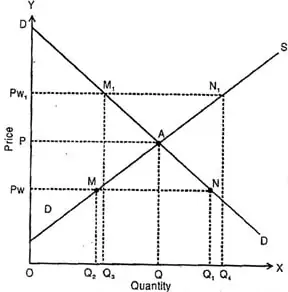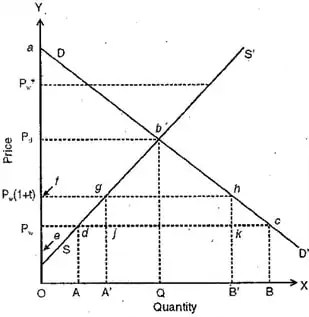Explain the Partial Equilibrium Theory of Trade.
Partial Equilibrium Theory of Trade is an extension of basic micro-economic theory of equilibrium. Equilibrium price is the price at which both demand and supply of a commodity are equal or in balance. Partial equilibrium theory is based on the assumption of perfect competition, which is characterized by a large number of producers and consumers of a commodity. Partial equilibrium theory emphasizes that the society is better off with trade than with autarky (no trade), if a government restricts the trade. The society will be deprived with the welfare.

In the diagram, quantities are shown on the X-axis while prices are shown on the Y-axis. DD is the demand curve while SS is the supply curve. Both these curves intersect at point A resulting in OP as market price and OQ as equilibrium quantity.
If there is autarky in the country the consumers welfare is equilibrium will be DAP. Now, the world price of the product is OPw which is lower than domestic (no trade) price OP and the country takes the world price are given. At world price OPw, the produces will produce OQ2 while consumers will demand OQ1 It implies the quantity equal to MN or Q2Q1 will be imported. As a result of import, the consumers welfare will increase from DAP to DNPw.
But the import will hurt the domestic firms as their production will come down to OQ2 from OQ. Trade would increase total social welfare because producers loss is less than the consumers gain.
Now, we take the case when the world price of the product is OPw, which is more than domestic (no trade) price OP. At world price OPw1, producers will produce OQ4 while the demand is only OQ3. As a result, the producers will export the product equal to M1N1 because domestic demand is less than the supply.
To sum up, we find that free trade results in increase in total social welfare in both the cases. If there is no trade, total social welfare (including producers gain and consumers gain) is PA or OQ. If world price is less than domestic price (say OPw) total social welfare is PwN or OQ1 in,case there is free trade. If world price is more than domestic price (say OPw1) total social welfare is Pw1 N1 or OQ4 in case there is free trade.
Now we take up a case when the domestic government imposes a tariff at rate t. As a result of this volume of international trade would decline but volume of domestic production would rise and volume of domestic consumption will fall. As a consequence producer surplus would rise and consumer surplus would fall. But overall national welfare would fall because of the dead weight losses from the tariff. This be shown in the diagram below:

In this diagram we find that when world price is Pw, supply of commodity is OA and demand of commodity is OB. There will be import of commodity equal to AB. When, as a result of tariff, world price is made up Pw (1++), the supply of domestic producers will go upto OA but demand will fall to OB. The volume of import will shrink to A’B’.
As a result, domestic consumer surplus falls, producer surplus rises and the domestic government gets a tariff. In addition, there is dead weight loss which accrues to no one. The post tariff total welfare is less than free-trade total welfare since net loss to the society is equal to triangular areas namely gfd and hkc.
However for a country having a monopoly power in the world market i.e. power to influence the world price, a tariff may not be a bad idea since it may have a positive impact on social welfare. Such a country will not find free trade to be the best policy, but will find an optimum tariff rate which maximizes its social welfare.
Partial equilibrium theory is criticized on the ground that it focuses on one market while markets are generally inter-related. A change in any market has spillover effects on other markets and the change in these other markets will in turn, have repercussion or feedback effects on the original market.
Thus partial equilibrium theory ignores the interaction between goods. Partial equilibrium theory does not explain the pattern of trade between two countries. In-spite of this limitation, partial equilibrium theory is useful since it shows the effect of free trade or a tariff.


